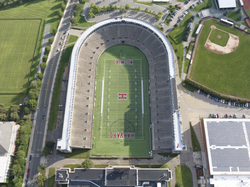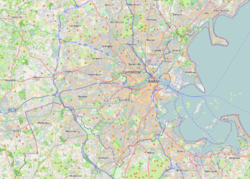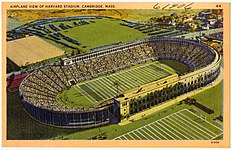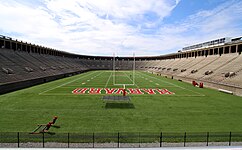
The Harvard Crimson is the nickname of the intercollegiate athletic teams of Harvard College. The school's teams compete in NCAA Division I. As of 2013, there were 42 Division I intercollegiate varsity sports teams for women and men at Harvard, more than at any other NCAA Division I college in the country. Like the other Ivy League colleges, Harvard does not offer athletic scholarships.

CEFCU ('sef-kyü) Stadium, formerly known as Spartan Stadium, is an outdoor athletic stadium on the west coast of the United States, located in the Spartan Keyes neighborhood of central San Jose, California. Owned by San José State University, the venue is the longtime home of Spartan football; it also hosts the university's commencement ceremony on Memorial Day weekend, and occasional high school football games. Known as Spartan Stadium for over eight decades, it was renamed in 2016.

Michigan Stadium, nicknamed "The Big House," is the football stadium for the University of Michigan in Ann Arbor, Michigan. It is the largest stadium in the United States and the Western Hemisphere, the third-largest stadium in the world, and the 34th-largest sports venue in the world. Its official capacity is 107,601, but it has hosted crowds in excess of 115,000.
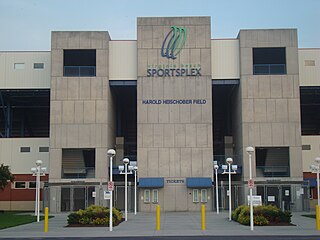
The Virginia Beach Sportsplex is a sports complex in Virginia Beach, Virginia. The name is most commonly attached to the main stadium within the complex, which opened in 1999. It has a permanent seating capacity of 6,000, on two decks of seating, though it can be expanded upwards to 17,000 for American football games. It was the first soccer-specific stadium built from the ground up in the United States. The Sportsplex is located across the street from the Princess Anne Athletic Complex and near the Veterans United Home Loans Amphitheater.

The Cornell Big Red is the informal name of the sports teams, and other competitive teams, that represent Cornell University, located in Ithaca, New York. The university sponsors 37 varsity sports, as well as numerous intramural and club teams. Cornell participates in NCAA Division I as part of the Ivy League. The men's and women's ice hockey teams compete in the ECAC Hockey League. Additionally, teams compete in the National Intercollegiate Women's Fencing Association, the Collegiate Sprint Football League, the Eastern Association of Rowing Colleges (EARC), the Eastern Association of Women's Rowing Colleges (EAWRC), the Middle Atlantic Intercollegiate Sailing Association, and the Eastern Intercollegiate Wrestling Association (EIWA).

The Bright-Landry Hockey Center is a 3,095-seat ice-hockey arena in the Allston neighborhood of Boston, Massachusetts, United States. It is home to the Harvard University Crimson men's and women's ice hockey teams. It is named for Alec Bright class of 2019, a former hockey player.

The Ray Lavietes Basketball Pavilion at the Briggs Athletic Center is a 1,636-seat multi-purpose arena in the Allston neighborhood of Boston. Owned by Harvard University, it is the second-oldest college basketball arena still in use.
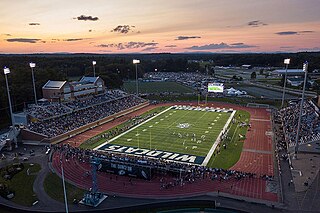
Wildcat Stadium is an 11,015-seat open-air multi-purpose stadium in Durham, New Hampshire, on the campus of the University of New Hampshire (UNH). It is home to the New Hampshire Wildcats football, lacrosse and track and field varsity teams. The stadium, which runs west-northwest, consists of a FieldTurf playing surface surrounded by a 400-metre track. On either side of the track are aluminum stands. The stadium lies just southwest of the Field House, which houses Lundholm Gym as well as Swazey Pool and the Jerry Azumah Performance Center.
The James M. Shuart Stadium is an 11,929-seat multi-purpose stadium and sports facility, the facility serves as the home to Hofstra's lacrosse teams on the campus of Hofstra University in Hempstead, New York. First opened in 1963, and remodeled in 1996 and 2013, it was known as Hofstra Stadium until August 29, 2002, when it was renamed after the former president of Hofstra University, who played lacrosse and football during his undergraduate years at the school. The stadium grounds include James C. Metzger Hall which houses the stadium's press box, luxury suites and the Fried Center for Student-Athlete Development.
Warren McGuirk Alumni Stadium is a 17,000-seat multi-purpose stadium in Hadley, Massachusetts, on the campus of the University of Massachusetts Amherst.

Shotwell Stadium is a stadium in Abilene, Texas. It was built in 1959, using Rice Stadium as a model. It was initially named the Public Schools Stadium. The first game played in the stadium was in the fall of 1959. Shortly after the first season, the stadium was renamed Shotwell Stadium, after P. E. Shotwell, a longtime football coach at Abilene High School.
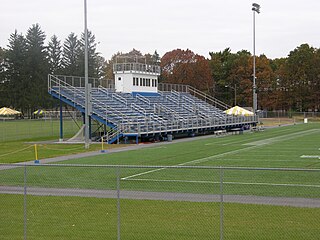
Golden Bear Stadium is a multipurpose outdoor sports facility on the campus of Western New England University in Springfield, Massachusetts. It features a synthetic turf field. The 1,500-seat stadium serves as the home field for Western New England University's football, field hockey, and men’s and women’s lacrosse teams.
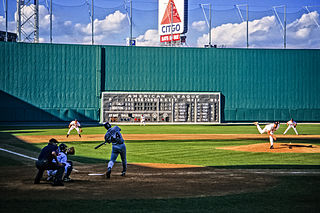
Boston, Massachusetts, is home to several major professional sports franchises. They include the Red Sox (baseball), the Celtics, and the Bruins. The New England Patriots and the New England Revolution play at Gillette Stadium in nearby Foxborough, Massachusetts.

The Harvard Crimson football program represents Harvard University in college football at the NCAA Division I Football Championship Subdivision. Harvard's football program is one of the oldest in the world, having begun competing in the sport in 1873. The Crimson has a legacy that includes 13 national championships and 20 College Football Hall of Fame inductees, including the first African-American college football player William H. Lewis, Huntington "Tack" Hardwick, Barry Wood, Percy Haughton, and Eddie Mahan. Harvard is the tenth winningest team in NCAA Division I football history.
Sweeney Field is a multi-use sports facility on the Saint Joseph's University campus in Philadelphia, Pennsylvania, which opened in 1929 and was originally planned to be the centerpiece to a 70,000 seat football stadium in the natural bowl of the campus.
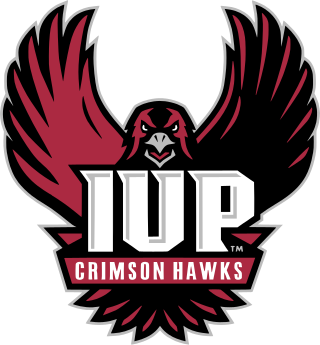
The Indiana University of Pennsylvania Crimson Hawks, commonly known as the IUP Crimson Hawks and formerly called the IUP Indians, are the varsity athletic teams that represent Indiana University of Pennsylvania, which is located in Indiana, Pennsylvania. The university and all of its intercollegiate sports teams compete in the Pennsylvania State Athletic Conference (PSAC) within the NCAA Division II. The university sponsors 19 different teams, including eight teams for men and eleven teams for women: baseball, men's and women's basketball, men's and women's cross country, women's field hockey, football, men's golf, women's lacrosse, women's soccer, softball, men's and women's swimming, women's tennis, men's and women's indoor and outdoor track and field, and women's volleyball.

The Harvard Crimson men's lacrosse team represents Harvard University in National Collegiate Athletic Association (NCAA) Division I men's lacrosse. Harvard competes as a member of the Ivy League and plays its home games at Cumnock Turf and Harvard Stadium in Cambridge, Massachusetts.
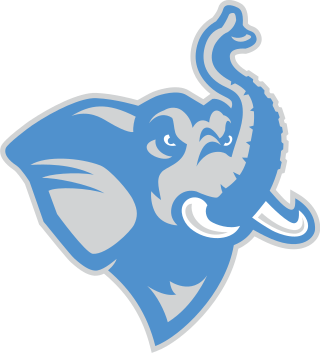
The Tufts Jumbos are the varsity intercollegiate athletic programs of Tufts University, in Medford, Massachusetts. The Jumbos compete at NCAA Division III level as member of the New England Small College Athletic Conference (NESCAC). Like all Division III schools, Tufts does not offer athletic scholarships. Coed and women's sailing are the only Division I sports at the school.

Jordan Field is a multi-purpose stadium on the campus of Harvard University in the Allston neighborhood of Boston.

The Framingham State Rams are composed of 14 varsity teams representing Framingham State University in intercollegiate athletics. All teams compete at the NCAA Division III level and all teams compete in the Massachusetts State Collegiate Athletic Conference (MASCAC).

